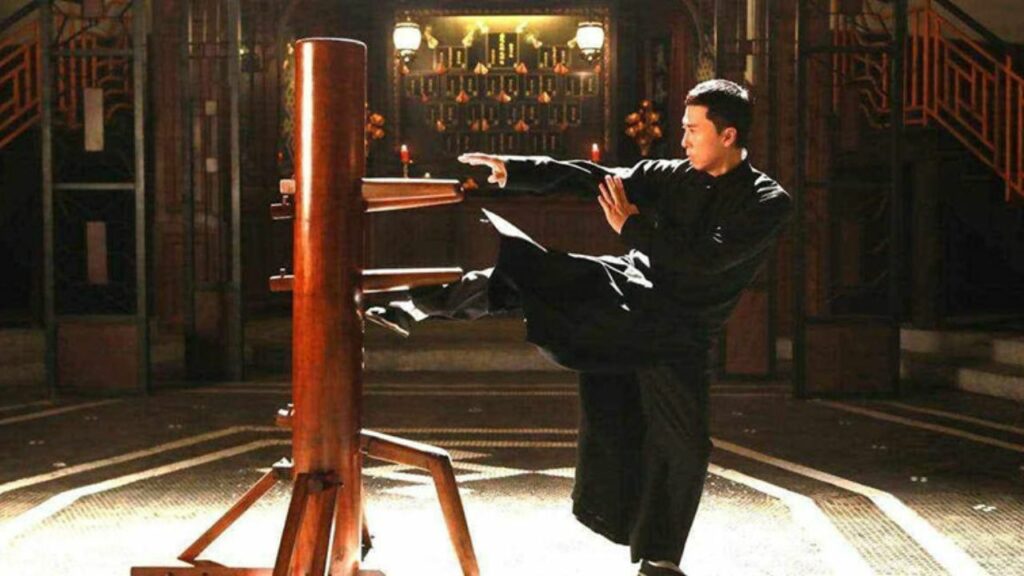Wing Chun has long been established as one of the most important martial arts in the world. It’s highly unique and is notable for its efficiency of movement and direct lines of attack. However, just how effective would it be in MMA or a real fight?
That’s what we’re going to examine here. We’ll look at how effective Wing Chun is and how relevant it is to real-world scenarios. We’ll also answer some common FAQs about Wing Chun so you have all the info you need. Let’s go!
Table of Contents
What is Wing Chun?
Wing Chun is a traditional Chinese martial art that was invented around 300 years ago by a woman called Ng Mui and named after one of her students. It has become famous for its practicality and efficiency, especially in close-range combat.
Wing Chun is all about direct movements with no wasted motion or energy. There are many principles of Wing Chun, especially its centerline theory which is meant to keep the fighter perfectly balanced at all times. This centerline stance allows you to neutralize any attacks and quickly counter.
What Makes Wing Chun Effective in MMA/Real Fights
Many ask is Wing Chun a good martial art? Well, there are many advantages of Wing Chun which can make it effective in real fights. Here we’ll look at why it can be so successful.
Simplicity – Most Wing Chun techniques are very simple and you don’t need to worry about making any elaborate movements. This not only makes them easier to learn but also easy to remember when under the pressure of a real fight.
Close-Range Combat – If you’re in a situation where you need to rely on close combat, then the techniques of Wing Chun are going to work perfectly.
Efficiency – One of the biggest hallmarks of Wing Chun is its efficiency of movement. With each attack, you’ll be focusing on the shortest distance to your opponent. This is not only effective but helps you to preserve your energy.
Speed – Speed is a huge part of what makes Wing Chun so devastating. Not only will you develop the ability to throw fast punches, but the techniques of Wing Chun can also allow you to chain punch to overwhelm your opponents.
Sensitivity – As you become a Wing Chun expert, you can learn to control your opponent’s movements. Not only that, but you’ll become highly sensitive to what moves they are making so you can control the fight.
Disadvantages of Wing Chun
While there are many advantages of Wing Chun, it’s also important to talk about the disadvantages when it comes to Wing Chun in a real fight. Let’s check them out.
Lack of Power – Wing Chun relies on speed and being able to strike your opponent in the shortest time and in the shortest distance. However, the downside to this is that its exponents lack power as there is little rotational force behind the strikes.
Less Balance – The centerline stance that Wing Chun uses is effective for stand-up hand-to-hand combat but it can have some limitations. If your opponent moves laterally then it can be hard to stay balanced and keep that centerline stance solid.
No Takedown Defense – Another of the big negatives with that centerline stance is that it becomes very difficult to have a takedown defense. You are vulnerable to being taken to the floor as you are squared up to your opponent, making it difficult to quickly move backward.
No Grappling – You’ll struggle in real fights if you exclusively rely on Wing Chun. A big reason for that is that grappling is not a part of its teachings. If the fighting goes to the floor then you’ll either need to rely on your instincts or another martial art.
Which MMA Fighters use Wing Chun?
There are no active MMA fighters who used Wing Chun as their primary technique. As mentioned above, without using any other marital arts you’d be highly vulnerable to being taken down and you’d have no skills when it came to grappling.
That being said, we have seen a few fighters use Wing Chun in UFC as part of their overall skillset. Some notable examples of this include Tony Ferguson, Jon Jones, and Anderson Silva who have all used elements of Wing Chun in their fights.
Is Wing Chun effective in MMA? The truth is that a successful fighter needs to pick the best bits from several martial arts to develop a style that will be effective in the octagon.
10 Wing Chun Practical Techniques
It’s understandable to ask the question of is Wing Chun practical. However, in real-world scenarios, there are a number of different Wing Chun techniques which can have a practical application. Here we wanted to look at 10 of the most effective techniques.
1. Lin Wan Kuen (Chain Punch) – If you want to overwhelm your opponent then the Chain Punch can be a great way to do it. This is a rapid and continuous punching technique that makes maximum use of Wing Chun’s efficiency.
2. Tan Sau (Receiving Hand) – This technique is perfect for being able to redirect any incoming strikes. It’ll take your opponent’s punches or kicks away from the centerline and allow you to counter with devastating effect.
3. Bong Sau (Wing Arm) – This is an advanced-level move and one that is great for deflecting punches and allowing you to gain control over your wrists. It allows you to trap your opponent and come back with a counterstrike.
4. Fook Sau (Subduing Hand) – Fook Sau is more of a beginner move but would be highly effective in MMA. Not only can this control your opponent’s limbs but it can act as a foundation for more complex Wing Chun moves.
5. Lap Sau (Grabbing Hand) – This is another great move for those who want to master the art of counter-attacking. Here you pull your opponent close to you which enables you to deliver a strike with a high level of force.
6. Pai Jarn (Hacking Elbow Strike) – Pai Jarn is a brilliant striking move that you can use in any real-world scenario. It utilizes a horizontal hacking elbow as you either turn into or away from the opponent.
7. Wing Chun Double Punch – This is another epic move that is exactly what it sounds like. Both fists make rapid contact with your opponent for double the impact. It allows you to transfer all of your weight through your fists.
8. Huen/Hyun Sau (Circling Hand) – A huge part of Wing Chun is being able to control your opponent. That’s exactly what the Circling Hand does as it allows you to retain control over the fight and be in perfect position at all times.
9. Chi Sau (Sticking Hands) – Another important part of Wing Chun is having a feel for your opponent and anticipating their movements. Learning Chi Sau will allow you to rely on your other senses, and not just your sight.
10. Man Sau (Asking Hand) – If you wanted to be able to block high punches then the Man Sau will work very well. Not only can it protect you from overhand strikes, but it also allows you to quickly counter with an elbow.
Bottom Line: Is Wing Chun Effective?
Yes, Wing Chun can be effective in a real fight but it has some serious drawbacks. In the real world, fights don’t happen like they do in the movies and they often become scrappy brawls that end up on the floor.
It’s in these scenarios where Wing Chun alone isn’t going to be highly effective. However, if both combatants stand up and stay in close combat, it can be effective.
When taught well and with a lot of practice, the principles of Wing Chun can be used for self-defense. You are able to control the movement of your opponents through your sensitivity to movement and blocking techniques.
In reality, no single martial art is a perfect solution for MMA or real world fights. Wing Chun can be a useful addition to your skill set but would need to be combined with other disciplines.
FAQs
Is Wing Chun illegal in MMA?
No, not at all. Wing Chun can be used in MMA and you can apply its techniques in its fights. The only thing you need to be aware of is the illegal moves in MMA such as punches to the back of the head, groin shots, eye pokes, and 12 to 6 elbows. Due to this, some of the moves in Wing Chun may be illegal but the martial art itself is allowed.
Is Wing Chun good for self-defense?
If you wanted to become an expert in self-defense then it would be better to learn more general MMA training. That being said, Wing Chun can be effective in close-quarter combat due to its focus on practical techniques along with rapid hand speed and sensitivity training.
Is Wing Chun a good workout?
As with any martial art, Wing Chun can be a good workout as you need to be in excellent physical condition to become a master. It can not only help to improve your cardiovascular fitness but it will also help to work on your strength, flexibility, and coordination.
Is Wing Chun Kung Fu?
There are many different styles of Kung Fu and Wing Chun is one of them. While there are a vast number of different styles, there are seven main subsets of Kung Fu. Along with Wing Chun, the other six are Shaolin Kung Fu, Tai Chi, Northern Praying Mantis, Baguazhang, Xing Yi Quan, and Bajiquan
Is Wing Chun Dangerous?
Yes, any martial art is dangerous. While it places a lot of emphasis on self-defense, when used against an aggressor there are many Wing Chin techniques that can cause a lot of harm.
Is Wing Chun Useless?
Wing Chun is not useless at all. When it comes to does Wing Chun work in the real world, it has serious drawbacks but the same could be said for many martial arts. When used in combination with other fighting methods, the principles of Wing Chun can be highly useful.


